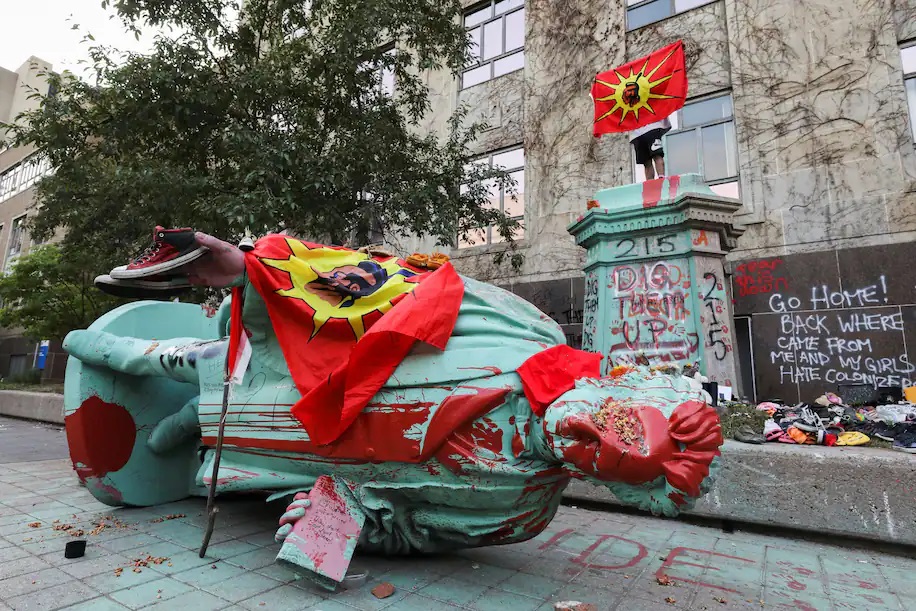TORONTO (CANADA)
Washington Post
June 7, 2021
By Miriam Berger and Amanda Coletta
[Photo above: A toppled and defaced statue of Egerton Ryerson, considered an architect of Canada’s residential Indigenous school system, following a protest at Ryerson University in Toronto on June 6. (Chris Helgren/Reuters)]
Protesters on Sunday toppled a statute of Egerton Ryerson — one of the key figures behind Canada’s residential school system, which separated some 150,000 Indigenous children from their homes — amid growing anger over the Catholic Church’s refusal to issue an apology for its role in the abuse students faced.
The rally at Ryerson University in Toronto was organized in response to news last month that the remains of 215 Indigenous children had been found in the yard of a former residential school run by the Catholic Church in British Columbia.
Since the Tk’emlúps te Secwépemc First Nation shared news of the unmarked burial site on May 27, members of the student body and Indigenous communities have renewed calls on the university to change its name and remove Ryerson’s statue.
In the wake of the statue’s toppling, university President Mohamed Lachemi said in a statement that it would “not be restored or replaced.”
The university, Canadian Prime Minister Justin Trudeau said at a forum there last week, “is going through a process right now around its own name, and I think what really matters is that these conversations be had in a responsible and mature fashion and that people are really listening.”
Pressure has also been mounting on the Catholic Church to issue a formal apology for its role in running schools such as Kamloops Indian Residential School and to hand over all the records that might help to identify unmarked burial sites and the students who died or went missing. The Church has so far refused to do so, despite a request from Trudeau at a meeting in 2017.
“That there are still church records that have not been revealed or made available … is a sad commentary on the lack of the commitment by the Catholic Church to allow us to investigate this further,” Murray Sinclair, a former chair of the Truth and Reconciliation Commission, told a parliamentary committee last week.
Rosanne Casimir, chief of the Tk’emlúps te Secwépemc First Nation, told reporters that she wants an apology from the Vatican. “We do want an apology — a public apology — not just for us, but for the world,” she said.
Pope Francis on Sunday said during his weekly blessing in St. Peter’s Square that he was pained by news of the remains and called for respect for native peoples’ rights and culture.
But he conspicuously fell short of issuing a formal apology.
“We’re all pained and saddened. Who isn’t? This is a worldwide travesty,” Chief of the Federation of Sovereign Indigenous Nations in Saskatchewan, Bobby Cameron, told Reuters, in response to Francis’s Sunday comments. “How hard is it for the pope to say: ‘I’m very sorry for the way our organization treated the First Nations people, the First Nations students during those times, we are sorry, we pray.’”
Trudeau, who is a Catholic, said last week that he was “deeply disappointed” in the Church’s refusal to apologize.
The Kamloops Indian Residential School, the largest in operation, was set up in 1890 and administered by the Roman Catholic Church until 1969. It closed down in 1978.
A 2015 commission by Canada’s Truth and Reconciliation Commission concluded that what happened to Indigenous students at schools like Kamloops constituted “cultural genocide.” They were banned from speaking their own languages and frequently subjected to abuse.
The report also found at least 4,100 students died while the schools were in operation, between 1831 and 1996 — though that number is considered an undercount because many deaths probably went undocumented.
An apology from the pope is among the 94 calls to action in the report.
Children housed in the schools often faced abuse, malnutrition, hard labor, rape and were at risk of death from fire, suicide and infectious diseases such as tuberculosis due to unsanitary living conditions. They died at rates far higher than students in other parts of Canada.
The Canadian government apologized in 2008 for the physical and psychological abuse Indigenous children endured at residential schools. It has since paid billions of dollars in compensations to survivors.
Many advocates say that is not enough to achieve justice or accountability.
“The culprits sort of get off scot-free,” Kamloops survivor Saa Hiil Thut, 72, told Reuters, on Sunday after Francis’s remarks.
He continued, “The pope won’t say, ‘You know what? I heard there was (thousands of) cases of physical and sexual abuse in those residential schools run by our church.’ He won’t say that. He won’t say ‘there’s 215 children in an unmarked grave in Kamloops and probably every residential school in Canada.’”

